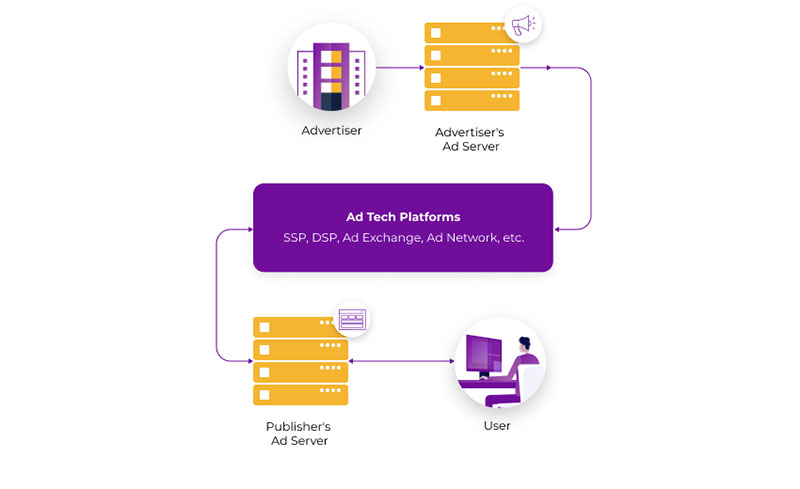Ad servers play an important role in the world of online advertising. They are responsible for storing and posting advertising on websites, social networks, and mobile applications. SSP, DSP, Ad Network, and Ad Exchange require integration with Ad server to effectively manage and optimize advertising campaigns. If you are wondering “What is an ad server and who uses it?”, then this article is for you.
What Is an Ad Server?
Ad server is a web server that is used to store advertising content and place it on various online platforms. Ad servers also collect statistics and provide reports to track the effectiveness of advertising campaigns. Thanks to the Ad server, advertising content is shown to the target audience in a fraction of a second.
Ad servers most often work in conjunction with DSP, SSP, ad networks, and ad exchanges. In this case, Ad servers serve as a tool for delivering and placing advertisements in targeted advertising spaces.
Types of Ad Servers
There are several types of Ad servers – local and remote Ad servers, as well as Ad servers of web publishers and advertisers.
- Local and remote ad servers.
The advertising server can be local or remote. A local Ad server belongs to a specific web publisher and allows you to manage advertising campaigns in its interests. Remote Ad server is provided by a third-party company or service provider. It is not tied to any specific website and can serve many web publishers. Popular examples of a remote server are Google Ad Manager, and Xandr (Microsoft).
- Advertising servers of web publishers and advertisers.
Advertising servers can also be divided into first-party (own servers on the side of the seller – the web publisher) and third-party (third-party servers on the side of the buyer – the advertiser). The servers run on the same technologies but perform different functions depending on who is using them.
The web publisher’s Ad server helps select the appropriate advertising content to display, collects statistics on user interaction with advertising, and allows you to track overall performance and analyze revenue. The server helps the publisher increase the value of their advertising inventory by serving ads to interested audiences. In other words, the Ad server selects ads for each user, taking into account targeting parameters.
The advertiser uses an Ad server to track conversions and performance indicators of advertising campaigns, determine targeting parameters, and manage budgets and advertising materials. The server is focused on achieving the advertiser’s goals and maximizing ROI.
How Ad Server works
Ad servers are used by publishers to display advertisements to the website audience. Most often, the Ad server is combined with advertising networks (Ad Network) and SSP to increase profitability.
Let’s look at how the publisher’s own Ad server works:
- A user visits a website. The browser sends a request to the server to load the content of the page.
- The server receives the request, returns the HTML code, and begins rendering the page content.
- The Ad server receives a request to fill an available ad slot.
- Ad server, based on user information (gender, age, geolocation, interests, etc.), selects suitable advertising creatives.
- Line items selected by the Ad server participate in an RTB auction for ad impressions, during which the winner is determined.
- The publisher’s Ad server sends the ad code to the website. The winner’s advertisement is shown to the user.
Third-party Ad servers are used by publishers to send and place advertisements and measure the effectiveness of advertising campaigns. Such servers work similarly to publishers’ own Ad servers, with the exception of the last stages.
Let’s look at how an advertiser’s third-party Ad server works:
- A user visits a website. The browser sends a request to the server to load the content of the page.
- The server receives the request, returns the HTML code, and begins rendering the page content.
- The Ad server receives a request to fill an available ad slot.
- Ad server, based on user information (gender, age, geolocation, interests, etc.), selects suitable advertising creatives.
- Line items selected by the publisher’s Ad server participate in an RTB auction for ad impressions, during which the winner is determined.
- The winning position returns the ad content URL (pointing to the advertiser’s Ad server) back to the browser.
- The browser makes a call to the advertiser’s Ad server.
- The advertiser’s Ad server delivers the advertisement to the website. The user sees the advertisement.
Benefits of Using Ad Server For Publishers
Ad server allows you to store advertising content and display it to your target audience upon request. Advertisers no longer need to manually send ad copy to each web publisher. Instead, serving an ad is as simple as a line of code that calls the ad directly from the Ad server every time it is needed. The advertiser, at the same time, uploads the content to the server only once. If desired, the advertiser can replace and add new materials online.
Some of the benefits of using Ad Server include:
- Fill optimization. Ad Server automatically selects the format and size of advertising content based on available advertising inventory.
- Effective targeting. Ad server selects ad creatives based on targeting parameters to match audience interests, increase advertising effectiveness, and improve user experience.
- Variety of formats. Ad server supports various types of formats, including banners, video ads, interactive ads, and others.
- Reporting and analytics. Both publishers and advertisers receive detailed reports that allow them to evaluate the effectiveness of advertising campaigns.
- Integration with various platforms. Ad server easily integrates with SSPs, DSPs, Ad Networks, and Ad Exchanges.
Wrapping It Up
The main task of an ad server in programmatic advertising is to coordinate the process of displaying ads on websites, mobile apps, and other digital platforms in response to requests from the DSP. This allows for efficient management and delivery of advertising material, as well as analysis of campaign results, to maximize their effectiveness. If you want to dive deeper into programmatic advertising, we recommend turning to SmartyAds, a company that provides advanced AI solutions for working with programmatic advertising.
- Design Collaboratively: UX/UI Apps Like Figma - April 28, 2024
- Unlocking Capabilities: What is JavaScript Used For? - April 28, 2024
- Creative Collages: Designing with Apps Like PicCollage - April 27, 2024









